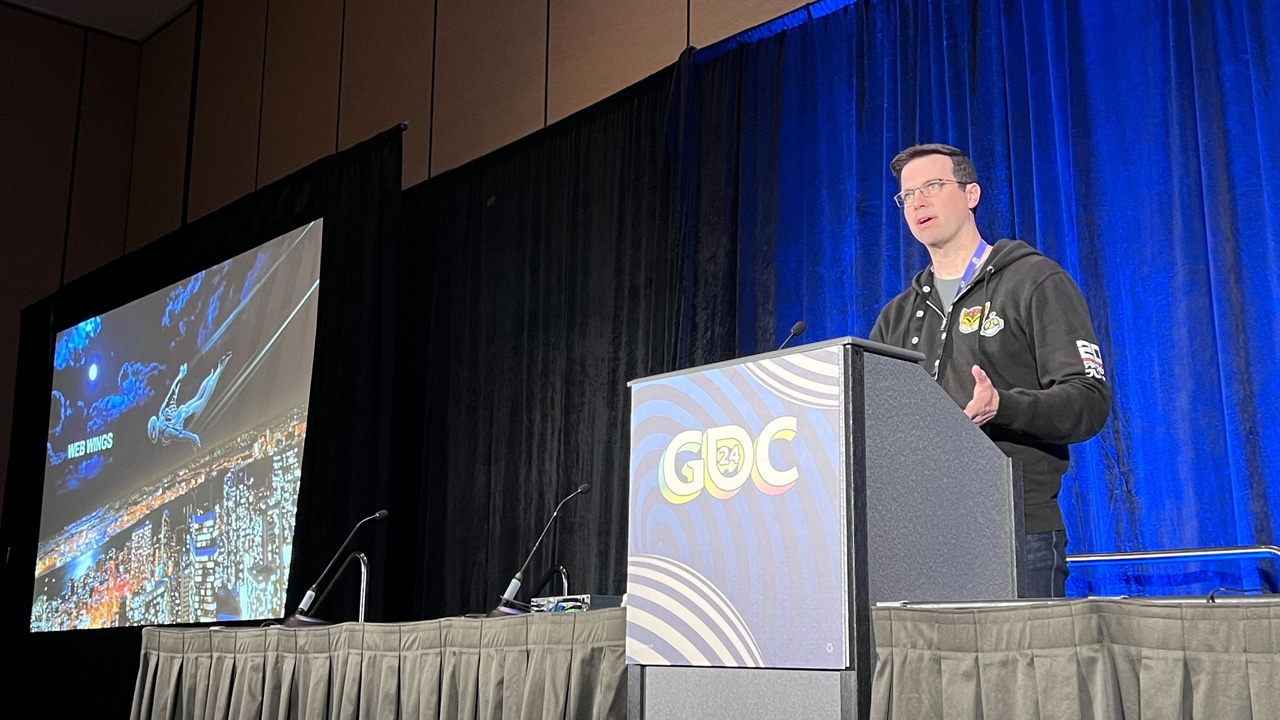
Read More from GDC 2024 | Keep up with the latest game industry event coverage from GDC 2024, including news, talks, interviews, and more from the Game Developer team.
How Spider-Man 2's traversal physics sling a faster superhero fantasy
The programming director of the superhero sequel explained the complex physics of Spider-Man and how the web-wings were a "mess" to get right.

Insomniac Games' efforts in the Marvel's Spider-Man series are seen as the most faithful and satisfying games to focus on the web-slinging heroes. Much of the acclaim comes from how intuitive the traversal system is, which was elevated further for the sequel with web-gliding.
Senior programming director Doug Sheehan spoke about the key areas in how they made web traversal faithful as seen in the movies and comics but still satisfying to control in Spider-Man 2. Along with using a whole lot of mathematics to calculate speed and trajectory, one of the core concepts for making a playable Spider-Man was to ensure that it would "feel authentic, but still fantastical."
During the panel, Sheehan broke down the key pillars for the traversal of Spider-Man 2. In addition to finding the depth of momentum and action—in how controlling the Spider-Men is engaging and satisfying for the long term—the programming director explained why Spider-Man's movement needed to be approached at all skill levels, simply because not many games do what Spider-Man can.
"The first two games in the franchise reached millions of players, many of whom came in at a wide variety of skill levels," said Sheehan. "What added to the challenge with making our games is that it required a unique sense of muscle memory that people don't really experience from other games—like the swinging, wall-running, and other stuff—that people can carry over into here. So we really had to have a level of ‘pick up and play’ with a fast-moving unique system that anyone who picks up a controller will feel like Spider-Man."
While the developers have a vast library of Spider-Man comics, films, and TV shows to pull from for reference, there's one element of being the web-slinger that game developers, in particular, have to show greater scrutiny over—and that's physics.
Granted, the Spider-Man games from Insomniac haven't gone for total realism, but the studio does focus on having a balance of realism and fantasy. This careful balance was crucial to ensure that the traversal system for both Peter Parker and Miles Morales was satisfying and, above all, fun.
2019's Spider-Man had a satisfying web traversal system. Still, with the 2023 sequel, the developers added web gliding, which introduced a variety of new technical hurdles to overcome, most of which came down to how to make it fun and desirable to use mechanically. During their early playtests, they made several adjustments and changes to the pitch and yaw of the web gliding, retaining a sense of "floatiness" for movement and adjusting how air momentum works. Unfortunately, the early web-gliding impressions internally led to disaster with playtesters, most of whom didn't find the feature's feel and implementation interesting.
"Initially, we thought our first plan for the web wings was great; we first had the concept of pressing the shoulder buttons down and pressing Triangle to deploy them," We refined it here and there, but it worked reasonably well for us overall. Once we gave it to our playtesters, it was an absolute mess. Players really wouldn't engage with the feature, and it got to the point where they said, "I don't like this," the only honest feedback we got was that it was clunky. We didn't get proper feedback on how the feature worked because they struggled with the basic barrier of getting deployed. "
"We tried all kinds of things before we finally said, ok, enough is enough. We then gave up on our kind of contract with the players with the shoulder buttons moved to a thing where you just have to tap Triangle—which is what shipped in the game. The response to this was immediate; players were immediately engaging with the Web wings, they were using them a lot more, and players were having a much better time with what we were doing."
Crucial work under the hood
Summing up his talk, Sheehan stated that a lot of work happens under the game's hood, which shows how much enhanced physics are in the game and how much of a helping hand is given to players to ensure they look and feel good playing as Spider-Man 2.

As the programming director described in the talk, the balance they have to hit when developing the game is marrying the enhanced physics and natural forces of the game with the player control and manipulated forces—which gives the game its signature flow. These come about in ways that show the player swinging and gliding above the city streets, narrowly missing structures and objects on buildings to get that familiar Spider-Man-like agility.
In many ways, Spider-Man 2 features some of the most satisfying and graceful open-world traversal gameplay, and that's a lot in part to how the game fine-tuned its in-world physics and movement.
The game carefully balances the give and take, having that Spider-Man-style grace and momentum while also not letting the physics of it all be too much of a damper. A key point that Sheehan stated towards the end of his panel summed up how and why the movement gameplay works so well, in that it was about giving "players a better sense of control, and making them feel like they're better at the game than they are to give them a more enjoyable experience."
Game Developer and GDC are sibling organizations under Informa Tech.
About the Author(s)
You May Also Like







.jpeg?width=700&auto=webp&quality=80&disable=upscale)



.jpg?width=700&auto=webp&quality=80&disable=upscale)




